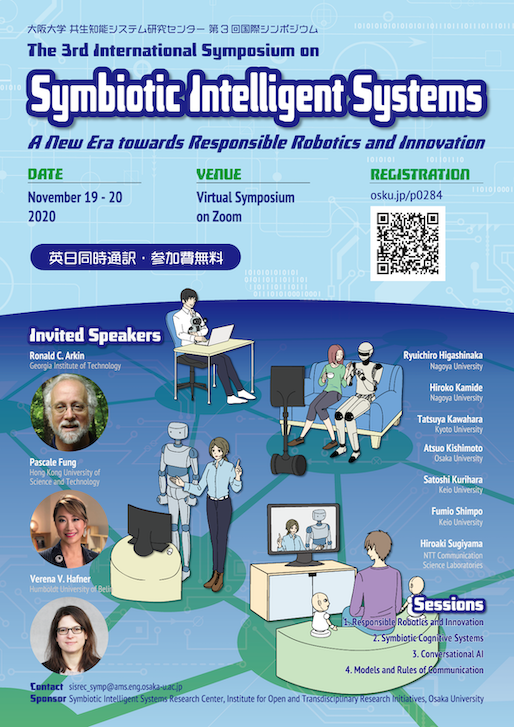The 3rd International Symposium on Symbiotic Intelligent Systems: “A New Era towards Responsible Robotics and Innovation”
The 3rd International Symposium on Symbiotic Intelligent Systems: “A New Era towards Responsible Robotics and Innovation” finished with a great success. Many thanks to everyone who participated despite the inconvenience caused by video conferencing.
Overview
| Date | November 19 – 20, 2020 |
| Time | 10:00 a.m. – 5:00 p.m. (Japan Standard Time) |
| Place | ZOOM Webinar See below for advanced preparations and precautions. |
| Program | See below * Click here to download presentation abstracts. |
| Fee | Free of charge |
| Language | English (Simultaneous English-Japanese interpretation is available.) |
| Registration | We stopped accepting applications. |
| Sponsor | Symbiotic Intelligent Systems Research Center, Institute for Open and Transdisciplinary Research Initiatives, Osaka University |
| Co-sponsors | “Legal Beings: Electronic personhoods of artificial intelligence and robots in NAJIMI society, based on a reconsideration of the concept of autonomy,” RISTEX, JST “An exploration of the principle of emerging interactions in spatiotemporal diversity,” CREST, JST |
| Cooperation | “Communicative intelligent systems towards a human-machine symbiotic society,” Grant-in-Aid for Scientific Research of Innovative Areas The Robotics Society of Japan |
Program (Abstracts)
Day 1 (November 19)
| Time (JST) | |
| Opening Remarks | |
| 10:00 – 10:10 | Takao Onoye (Osaka University, Vice-President) |
| 10:10 – 10:30 | Hiroshi Ishiguro (Osaka University) |
| Session 1 “Responsible Robotics and Innovation” Chair: Minoru Asada (Osaka University) |
|
| 10:30 – 11:15 | Ronald C. Arkin (Georgia Institute of Technology) “Civilized Collaboration: Ethical architectures for enforcing legal requirements and mediating social norms in HRI” |
| 11:15 – 12:00 | Atsuo Kishimoto (Osaka University) “Towards responsible innovation: Establishment of the “ELSI Center” at Osaka University” |
| 12:00 – 13:00 | Lunch break |
| Session 2 “Junior Researchers’ Presentations 1” Chair: Jihoon Park (Osaka University) |
|
| 13:00 – 14:15 |
|
| 14:15 – 14:30 | Break |
| Session 3 “Symbiotic Cognitive Systems” Chair: Erhan Oztop (Osaka University) |
|
| 14:30 – 15:15 | Hiroko Kamide (Nagoya University) “Psychological evaluation of a sense of security on robots” |
| 15:15 – 16:00 | Satoshi Kurihara (Keio University) “Emergent approach for symbiotic framework in creative work” |
| 16:00 – 16:15 | Break |
| 16:15 – 17:00 | Verena V. Hafner (Humboldt University of Berlin) “Robots with a self” |
Day 2 (November 20)
| Time (JST) | |
| Session 4 “Conversational AI” Chair: Hiroshi Ishiguro (Osaka University) |
|
| 10:00 – 10:45 | Tatsuya Kawahara (Kyoto University) “Spoken dialogue system (SDS) for conversational android ERICA” |
| 10:45 – 11:30 | Pascale Fung (The Hong Kong University of Science and Technology) “Deeper conversational AI” |
| 11:30 – 12:45 | Lunch break |
| Session 5 “Junior Researchers’ Presentations 2” Chair: Jihoon Park (Osaka University) |
|
| 12:45 – 14:00 |
|
| 14:00 – 14:15 | Break |
| Session 6 “Models and Rules of Communication” Chair: Yuichiro Yoshikawa (Osaka University) |
|
| 14:15 – 15:00 | Ryuichiro Higashinaka (Nagoya University) “Integrating understanding and generation modules for adaptive dialogue systems” |
| 15:00 – 15:45 | Hiroaki Sugiyama (NTT Communication Science Laboratories) “Building and utilizing “personalities” for communicative intelligent systems” |
| 15:45 – 16:00 | Break |
| 16:00 – 16:45 | Fumio Shimpo (Keio University) “The principal Japanese AI and robot strategy −Significance and legal implications” |
| Closing remarks | |
| 16:45 – 17:00 | Minoru Asada (Osaka University) |
Advanced Preparations and Precautions
- Each participant should have their own computer (PC, tablet, smartphone or other device), peripheral devices such as headphones, and a steady Internet environment. We are unable to address inquiries pertaining to computer settings, the Internet environment or other such matters.
- First time users of ZOOM should click here to download and install the app in advance (free of charge).
- In case you are unable to access the webinar, try reinstalling the most recent version of the app as this should potentially improve your problem.
- Each participant is responsible for the cost of Internet data communication (traffic) they incur during participation in the event.
- Use only one computer terminal (PC, tablet, smartphone or other device) per application.
- Refrain from taking photographs, video or making audio recordings of this event.
- During the event, participants’ cameras and microphones will automatically be turned off. Images of and sound/audio from participants will not be broadcast.
- Write your questions or comments in the Q&A window.
Contact
- For questions regarding this symposium, please contact the organizing committee at sisrec_symp_at_ams.eng.osaka-u.ac.jp (please change _at_ to @).

